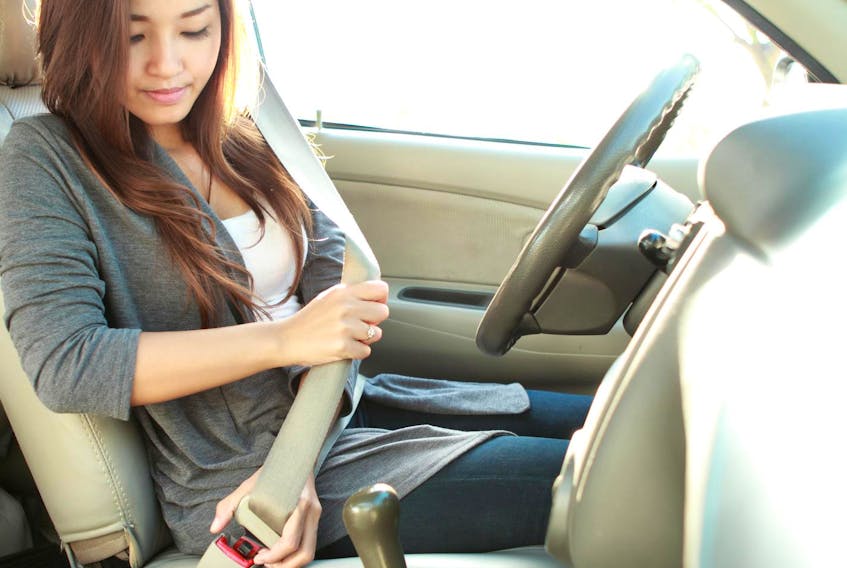Many drivers set the position of the seat in their vehicle once and forget about it. But many others have to change the position of the seat.
It could be that someone else using the vehicle, changed the setting. Or you are driving a vehicle that is new to you whether a loaner, a rental or a new one.
Few drivers realize the role proper position plays in operating the controls, vision and maximizing the effectiveness of the safety equipment.
When entering a vehicle for the first time, whether to merely move it, or to start a trip, take a few moments to ensure proper seat positioning.
This starts from the bottom up. The first step is to adjust the fore/aft direction. Make sure your bottom is placed as far back in the seat as possible with your back firmly pressing against the backrest.
From this position move the seat forward or back until you can comfortably place your right foot on the floorboards “behind” the brake pedal with your knee slightly bent.
Merely checking to see if you can reach the brake is not enough. In an all-out emergency stop, you want to be able to place the maximum pressure possible on the brake pedal with your right foot and brace yourself with the left.
You may be surprised how far down the brake pedal will go in emergency braking. You want to use those big muscles of your thighs for braking and bracing.
Now, adjust the height of the seat — if you have the option. Generally speaking, you should be sitting as high as possible to ensure maximum visibility. The higher you are, the further down the road you will be able to see.
Height also determines how close to the vehicle you will be able to see — in all directions. If you are height-challenged, you might want to consider a seat cushion to raise you to the point where you can see properly.
Chose the cushion carefully, making sure it is not too small or stiff, allowing you to wobble around on it. A larger cushion will permit you to sink into it and remain in place, held there by properly fastened and located belts.
Once we have the fore/aft position and height adjusted, it is time to set the angle of the backrest. While it may be comfortable to recline the seat back for the short term, it is a proven fact that near upright positioning places less pressure on the lower back for better long trip comfort and encourages alertness.
The determining factor in setting the backrest angle may well be the relationship with the steering wheel and the airbag contained therein. To allow sufficient space for the airbag to deploy in an emergency, our chest should be a minimum of 20 cm from the wheel — the centre portion of the wheel containing the airbag. Preferably we can allow at least 25 cm of space. If you are fortunate enough to drive a vehicle equipped with a telescoping wheel use that feature to more accurately set your distance.
Just as important as sitting far enough from the wheel to allow room for airbag deployment, is the significance of not sitting too far away. If we are too far from the wheel we will not be able to turn it properly in an emergency.
For most people one quick way to determine the proper position in relation to the wheel is to stretch your arms out in front of you, reaching over the top of the wheel.
If you can drape your hands over the top of the wheel rim at the wrists without pulling your back away from full contact with the seat back, you will be able to drop your hands and grasp the sides of the wheel between the eight and ten o’clock position on one side and two and four o’clock on the other with a slight bend at the elbows.
Now we’ve got the seat set. Not quite. Don’t forget to adjust the head restraint — notice I said head restraint, not head rest. This valuable safety item is designed to restrain your head in a crash and help prevent dreaded whiplash. If the restraint is set too low your head can be snapped back over the top, actually increasing the likelihood of whiplash. It should be raised (or lowered) so that the middle of your head comes into full contact with the restraint, not the back of your neck.
Now that we are in position it is time to set the mirrors. The rear view mirror should be set to properly frame the rear window ensuring the maximum visibility to the rear. Set it to show the two rear pillars as well as the roofline and the bottom of the window.
Generally speaking, the average driver fails to set the side mirrors to view see the adjacent lane, thus practically eliminating the “blind spot.” The incorrect and common method is to rely on them instead, to see to the rear.
Last but by no means least, the belts. Fasten the seat/shoulder belt and, bracing yourself with both feet, push your bottom and back firmly into the seat. Make sure the lap portion of the belt is pulled down over your hipbones to prevent the belt riding up in a crash.
Next adjust the shoulder belt height — if possible — to make sure it does not allow the belt to fall off your shoulder by being too low. Now grasp that shoulder belt and give it a firm tug to pull it tight across your lap, check your mirrors again and you are ready to drive.









